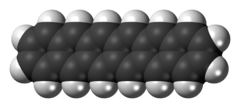Hexacene
| | |
 | |
| Names | |
|---|---|
| IUPAC name
Hexacene | |
| Identifiers | |
| 258-31-1 | |
| 3D model (Jmol) | Interactive image |
| ChemSpider | 109666 |
| PubChem | 123044 |
| |
| |
| Properties | |
| C26H16 | |
| Molar mass | 328.41 g/mol |
| Except where otherwise noted, data are given for materials in their standard state (at 25 °C [77 °F], 100 kPa). | |
| | |
| Infobox references | |
Hexacene is an aromatic molecule consisting of six linearly-fused benzene rings. Hexacene and its derivatives are investigated for potential applications as organic semiconductor.
Hexacene is one of a series of linear acenes, the previous one being pentacene (five fused benzene rings) and the next one being heptacene (seven fused benzene rings).[1]
Hexacene is very unstable, being highly reactive in the 6, 15 positions due to pi electron localization. Its spectra must be collected on freshly purified samples handled in an inert atmosphere such as nitrogen or argon. Only with very large substituents it is possible to isolate an hexacene for instance the compound 6,15-bis(tri-t-butylsilylethynyl)hexacene which melts with decomposition at 96 °C.[2]
The first reported synthesis of hexacene itself dates back to 1939.[3][4][5] In 1955 the compound is synthesized by dehydrogenation of hexacosadehydrohexacene by palladium on carbon.[6] In 1982 hexacene is reported as a bluish green compound with decomposition at 380 degrees.[7] In 2007, a research group claimed the first reproducible unsubstituted hexacene synthesis (invalidating the previous claims) based on photochemical decarbonylation of a diketone precursor:[8]
The compound could not be isolated: it dimerized even at concentration as low as 10−4 M and reacted in solution with oxygen to the organic peroxide. In a PMMA polymer matrix on the other hand these side-reactions were limited and the compound survived up to 12 hours. The next homologue heptacene also studied by this group, was even more unstable (decomposes within 4 hours).
The synthesis of hexacene has also been reported from a monoketone precursor.[9] by solid state synthesis at 180 °C as a crystalline solid. This solid was reported stable in the dark for up to a month, attributed to its herringbone packing preventing dimerization.
References
- ↑ The CAS registry number is
- ↑ Payne M. M.; Parkin S. R.; Anthony J. E. (2005). "Functionalized higher acenes: hexacene and heptacene". Journal of the American Chemical Society. 127 (22): 8028–9. doi:10.1021/ja051798v. PMID 15926823.
- ↑ Marschalk, C. Linear hexacenes. Bull. Soc. Chim. Fr. 6, 1112–1121 (1939).
- ↑ Clar, E. Aromatic hydrocarbons. XXIV. Hexacene, a green simple hydrocarbon. Ber. Dtsch. Chem. Ges. B 72B, 1817–1821 (1939).
- ↑ E. Clar (1942). "Eine neue Synthese des Hexacens (Aromatische Kohlenwasserstoffe, XXXIV. Mitteil.)". Berichte der deutschen chemischen Gesellschaft. 75 (11): 1283–1287. doi:10.1002/cber.19420751102.
- ↑ Cyclic Dienes. XI. New Syntheses of Hexacene and Heptacene William J. Bailey and Chien-Wei Liao J. Am. Chem. Soc.; 1955; 77(4) pp 992 - 993; doi:10.1021/ja01609a055
- ↑ Angliker H.; Rommel E.; Wirz J. (1982). "Electronic spectra of hexacene in solution (ground state, triplet state, dication and dianion)". Chemical Physics Letters. 87 (2): 208–12. doi:10.1016/0009-2614(82)83589-6.
- ↑ Revisiting the Stability of Hexacenes Rajib Mondal, Ravi M. Adhikari, Bipin K. Shah, and Douglas C. Neckers Org. Lett.; 2007; 9(13) pp 2505 - 2508; (Letter) doi:10.1021/ol0709376
- ↑ The synthesis, crystal structure and charge-transport properties of hexacene Motonori Watanabe, Yuan Jay Chang, Shun-Wei Liu, Ting-Han Chao, Kenta Goto, Md. Minarul Islam, Chih-Hsien Yuan, Yu-Tai Tao, Teruo Shinmyozu& Tahsin J. Chow Nature Chemistry 4,574–578 (2012) doi:10.1038/nchem.1381
